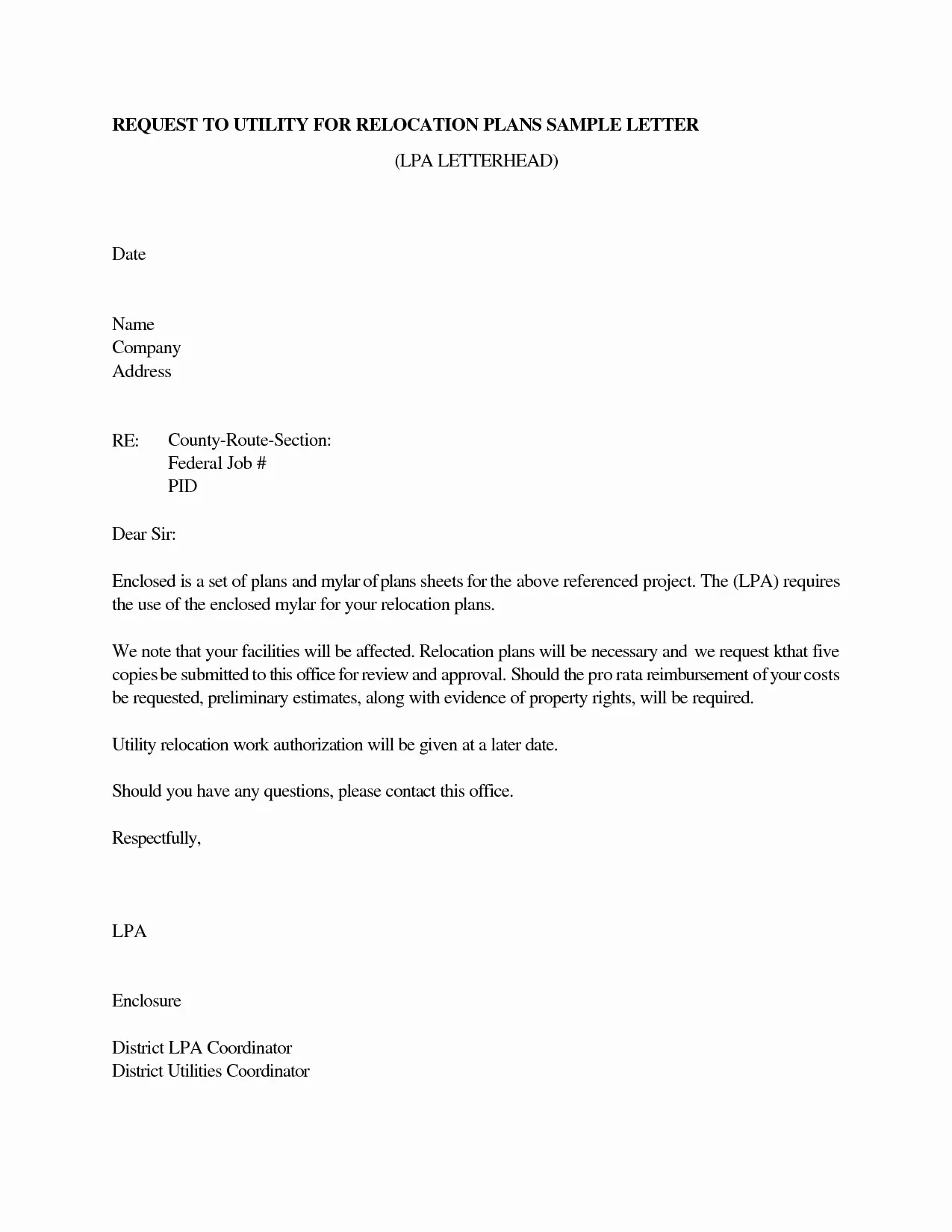Top 5 Secrets to a New Teacher Cover Letter
Landing your first teaching job can feel daunting, but a well-crafted cover letter is your secret weapon. A strong cover letter introduces you, highlights your skills, and expresses your passion for teaching. Unlike a resume, a cover letter lets you tell your story and connect with the hiring committee on a personal level. In this article, we’ll unveil the top 5 secrets to crafting a cover letter that grabs attention and helps you stand out from the crowd. Following these tips will significantly increase your chances of getting an interview and ultimately, your dream teaching position. Preparing a good cover letter is an essential step in your job search, allowing you to demonstrate what your resume simply cannot.
Highlighting Your Skills and Qualifications
Your cover letter is an opportunity to showcase the skills and qualifications that make you a great teacher. Start by identifying the key skills the school is looking for in a new teacher, often found in the job description. Focus on your abilities in classroom management, lesson planning, curriculum development, and student assessment. Give concrete examples of how you have used these skills effectively. Instead of simply stating that you are good at classroom management, describe a specific situation where you successfully managed a challenging classroom situation. Quantify your achievements whenever possible. For example, did you improve student test scores, implement a new teaching strategy, or receive positive feedback from students or parents? Use action verbs to describe your accomplishments and make your skills come alive.
Showcasing Your Education and Certifications
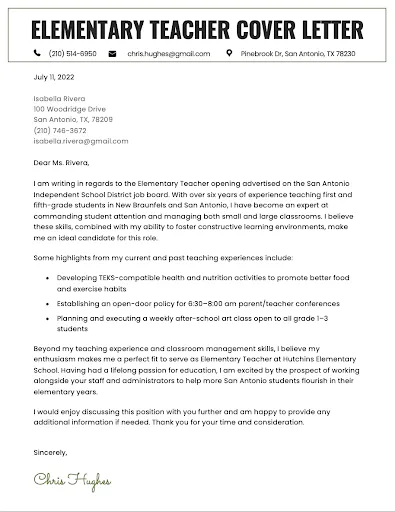
Clearly state your educational background and relevant certifications. Include the name of your college or university, your degree, and your major, as well as any honors or awards you received. Make sure to mention your teaching certifications and any special endorsements you may have, such as bilingual education or special education. If you are a recent graduate, you might want to include your GPA if it is impressive. Mention any professional development courses or workshops you have attended that are relevant to the position you are applying for. This section is your chance to prove that you are properly trained and prepared to teach. Demonstrate that you meet all the necessary requirements to hold a teaching position in the school.
Demonstrating Your Passion for Teaching
Teaching is more than just a job; it’s a calling. Your cover letter should reflect your genuine passion for teaching. Share your enthusiasm for working with children and your commitment to their learning and growth. Tell the hiring committee what motivates you to be a teacher. What inspires you to make a difference in the lives of your students? What are your core values, and how do they align with the school’s mission and values? Share a story or a specific experience that demonstrates your passion. This could be about a time when you helped a student overcome a challenge, created a memorable lesson, or saw a student achieve a breakthrough moment. Show them that you love what you do!
Expressing Your Enthusiasm and Dedication
Express your enthusiasm and dedication to the teaching profession in your cover letter. Use strong, positive language to convey your excitement about the opportunity. Show the reader that you are eager to learn and grow as an educator. Highlight your willingness to go the extra mile for your students and the school. This could include your commitment to ongoing professional development, your willingness to collaborate with other teachers, or your desire to participate in school activities. Let the school know that you are committed to creating a positive learning environment. They need to see that you are ready to invest your time, energy, and enthusiasm to make an impact. Make them want to choose you!
Tailoring Your Letter to the School
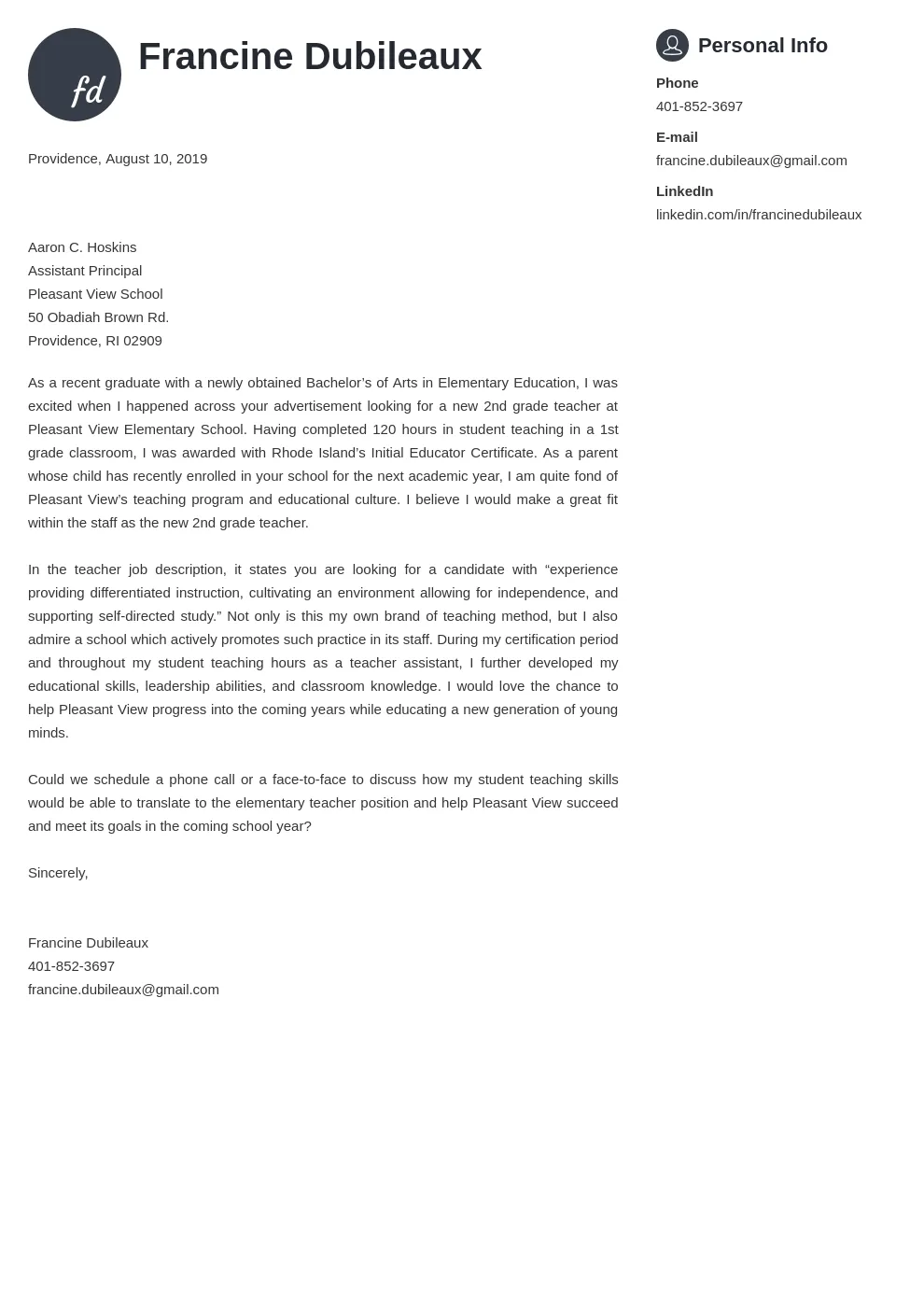
A generic cover letter is a sure way to get your application tossed aside. To make a strong impression, you need to tailor your cover letter to each school you apply to. Research the school’s mission, values, and programs. This shows that you are genuinely interested in the specific school. Find out what makes the school unique, and identify how your skills and experiences align with their needs. By showing a real interest in the school, you demonstrate that you are more than just applying for a job; you are looking for a place where you can contribute and grow.
Researching the School’s Values and Mission
Before you start writing, thoroughly research the school. Visit the school’s website, read their mission statement, and learn about their programs, initiatives, and values. Look for any information that might give you insight into the school’s culture and what they are looking for in a teacher. This could include information about the school’s approach to teaching and learning, its commitment to diversity and inclusion, and its involvement in the local community. Demonstrate that you understand their core values and can contribute to their mission. This shows the school that you are a good fit, that you care, and that you will invest in them.
Customizing Your Letter for Each Application
Once you have researched the school, customize your cover letter to reflect your understanding of their unique needs and values. Address the letter to a specific person, such as the principal or hiring manager, whenever possible. Mention specific programs, initiatives, or aspects of the school that resonate with you. Highlight how your skills and experiences align with the school’s needs and demonstrate how you can contribute to their success. This level of personalization shows that you have taken the time to understand the school and that you are genuinely interested in joining their team. Make the letter about them!
Emphasizing Relevant Experience
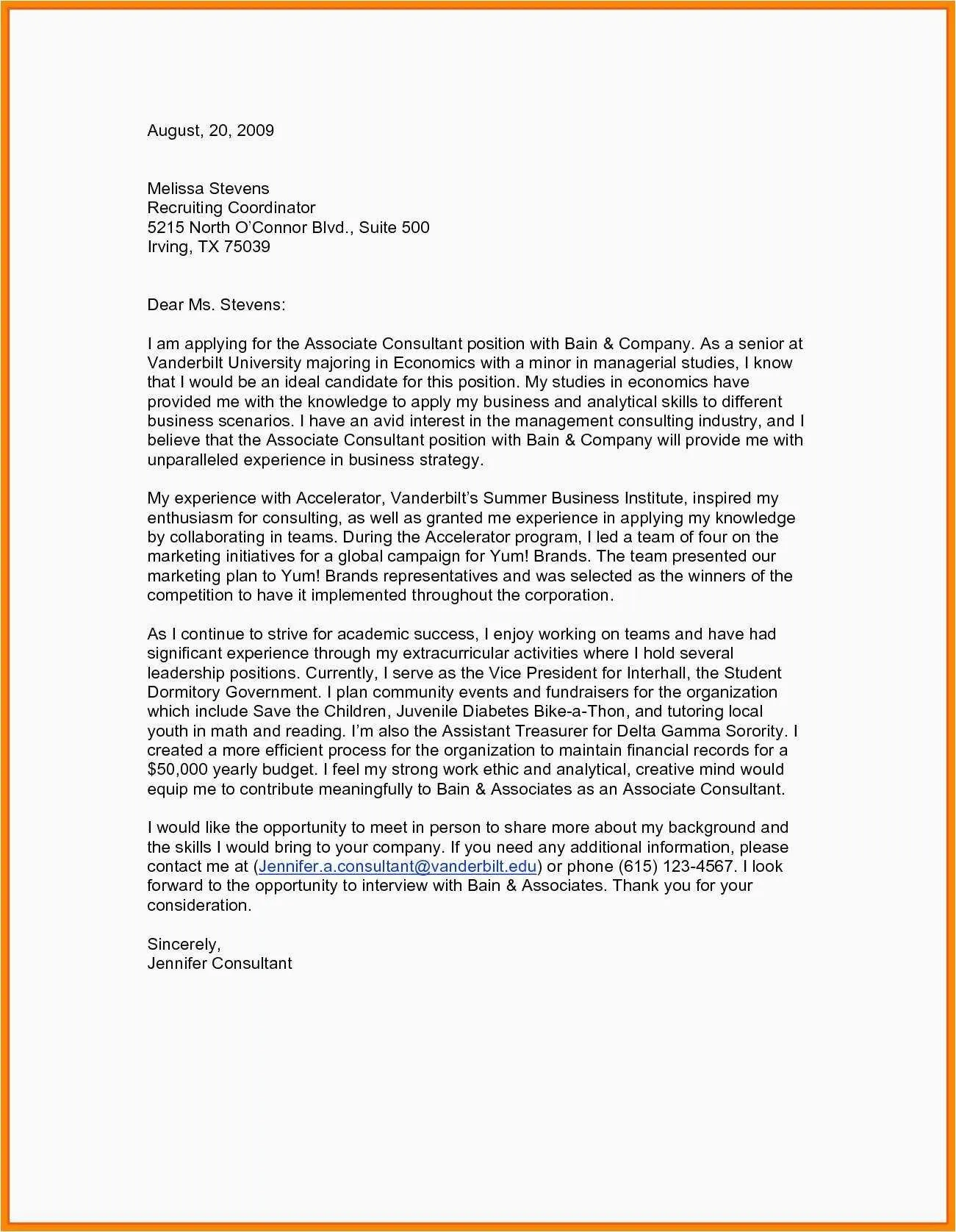
Highlight your relevant experience, including student teaching, internships, volunteer work, and any other experiences that have prepared you for teaching. Focus on the experiences that are most relevant to the position you are applying for. When describing your experiences, be specific and provide details about your responsibilities, the students you worked with, and the outcomes you achieved. If you have experience with specific grade levels, subject areas, or teaching methodologies, be sure to mention them. Show the hiring committee how your experience has prepared you to be a successful teacher. Showcase your relevant experience to demonstrate why you are a good candidate.
Using Action Verbs and Quantifiable Results
Use strong action verbs to describe your accomplishments and responsibilities. Verbs such as ‘developed’, ‘implemented’, ‘managed’, ‘assessed’, ‘collaborated’, and ‘motivated’ can make your cover letter more dynamic and engaging. Quantify your achievements whenever possible. Instead of saying you ‘improved student test scores’, mention the specific percentage increase. This shows the reader that you are results-oriented and that you can make a positive impact. For example, you could write, ‘Implemented a new reading program that resulted in a 15% increase in student reading comprehension scores.’ This will help you stand out.
Showcasing Student Teaching and Volunteer Work
Student teaching is a valuable experience. Highlight your accomplishments during this time. Describe your role, the students you worked with, the lessons you taught, and the positive outcomes you achieved. If you participated in any volunteer work, especially if it involved working with children or in an educational setting, make sure to include it. Show the hiring committee that you are committed to making a difference in the lives of children and that you are willing to go above and beyond. Student teaching and volunteer work can be a great way to demonstrate your enthusiasm for education and the impact you can make.
Closing with a Strong Call to Action
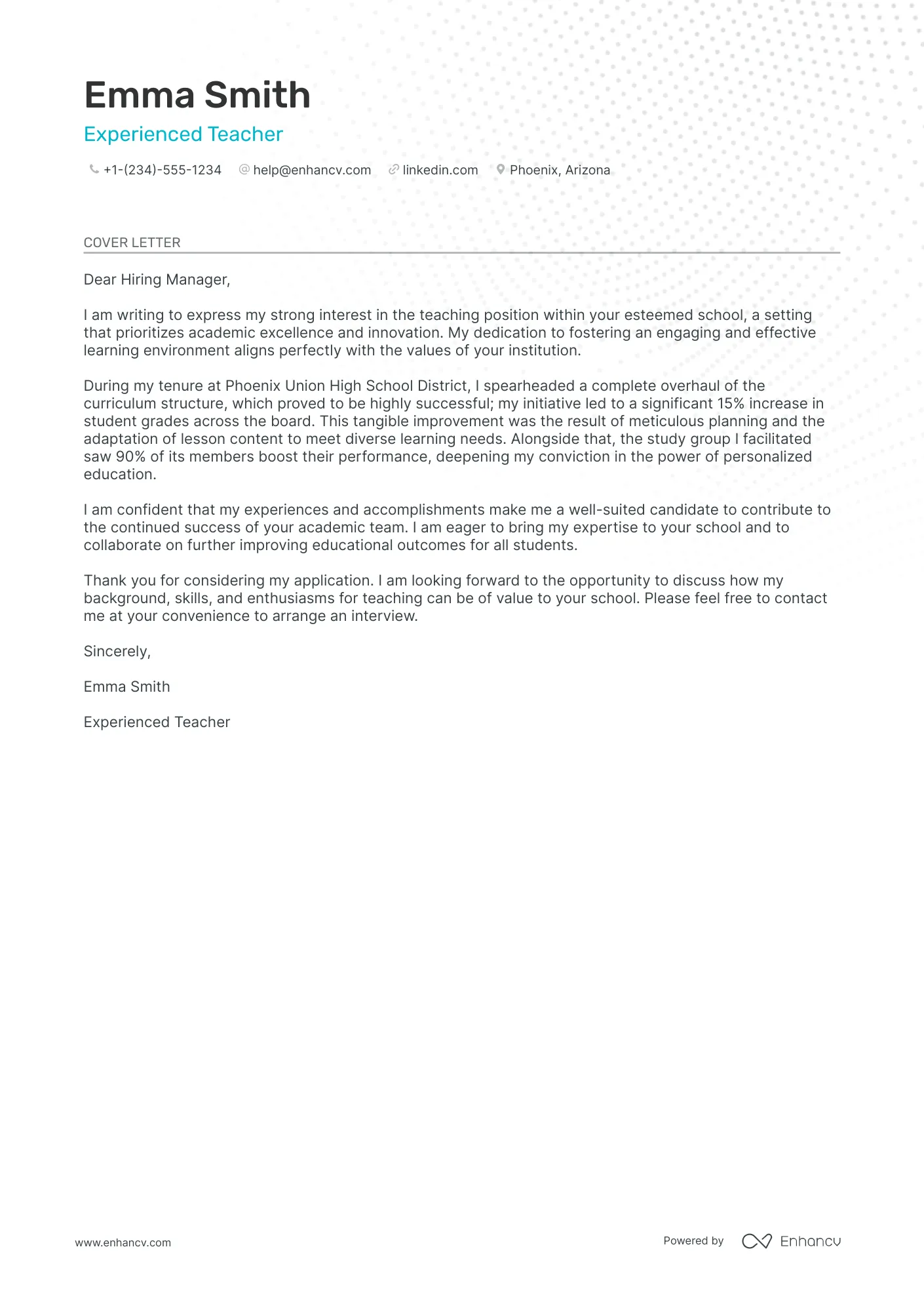
Your closing paragraph should leave a lasting positive impression and encourage the hiring manager to contact you. Reiterate your interest in the position and the school, and thank the reader for their time and consideration. Express your enthusiasm for the opportunity. End your cover letter by clearly stating your availability for an interview and providing your contact information. Keep it short and to the point. The goal is to make it easy for them to contact you.
Expressing Gratitude and Offering Availability
Thank the reader for their time and consideration. Reiterate your interest in the position and your enthusiasm for the opportunity to contribute to the school community. Express your availability for an interview. State that you are available for an interview at their earliest convenience and provide your contact information, including your phone number and email address. Closing a cover letter with a call to action is essential to moving the interview process forward. Make it easy for the hiring manager to take the next step and contact you!
Proofreading and Formatting Your Letter
Before you submit your cover letter, proofread it carefully for any errors in grammar, spelling, and punctuation. Ask a friend, mentor, or career counselor to review your letter for clarity and accuracy. Pay attention to the formatting, using a professional font, clear margins, and appropriate spacing. The overall appearance of your cover letter should be clean and easy to read. A well-formatted and error-free cover letter demonstrates your attention to detail and professionalism and will make a positive impression on the hiring committee. Proofreading is crucial.
In conclusion, a well-crafted cover letter is your ticket to landing a teaching interview. By highlighting your skills, demonstrating your passion, tailoring your letter to the school, emphasizing relevant experience, and closing with a strong call to action, you’ll significantly increase your chances of getting hired. Remember to proofread your letter carefully and submit it with confidence. Good luck with your job search!
